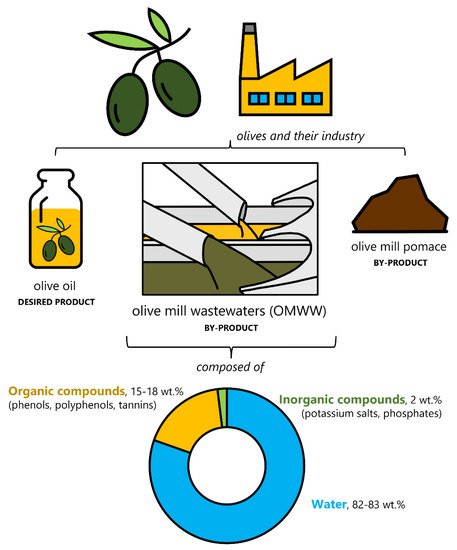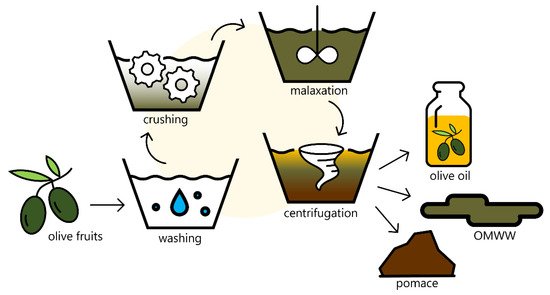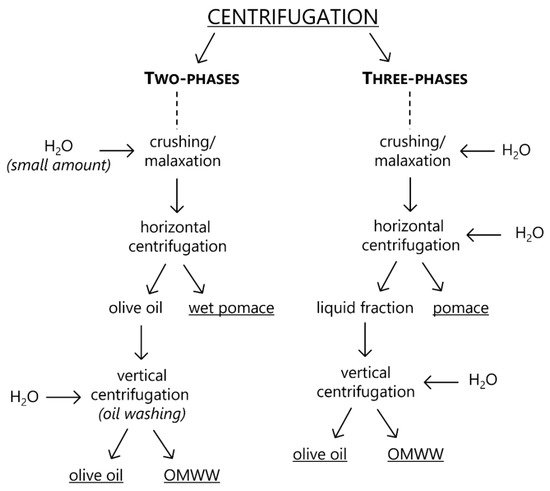Your browser does not fully support modern features. Please upgrade for a smoother experience.
Please note this is an old version of this entry, which may differ significantly from the current revision.
Subjects:
Chemistry, Applied
Olive oil production in Mediterranean countries represents a crucial market, especially for Spain, Italy, and Greece. Waste generated from olive oil production processes can be divided into solid waste and olive mill wastewaters (OMWW).
- olive oil production
- olive mill
- wastewater remediation
- polyphenols
1. Introduction
Olive oil production is a fundamental sector for several European (EU) States, especially Spain, Italy, and Greece. In particular, Spain has the largest area of olive cultivation (estimated at ca. 2.47 million ha), followed by Italy (ca. 1.16) and Greece (about 0.81 million ha) [1,2]. However, olive oil production is responsible for several environmental concerns (soil contamination, underground seepage, water-body pollution, and odor emissions) due to poor waste management practices [3]. In this scenario, concerning olive mill wastewaters (OMWW), special attention must be paid to their high phenolic content, which is responsible for their antibacterial effect, phytotoxic effect, and dark colour.
Recently, phenols, fatty acids, and volatile acids have been recognized as potentially hazardous for environmental health: the former have pronounced antimicrobial and phytotoxic properties, whereas the latter show toxicity due to their long alkyl chain.
All these components make OMWW toxic to anaerobic bacteria, thus inhibiting conventional secondary and anaerobic treatments in municipal water plants. Furthermore, the high BOD (biological oxygen demand) and COD (chemical oxygen demand) levels, which cannot be reduced by anaerobic digestion, represent a further threat to receivers [2,4]. Moreover, land spreading and treatment in evaporation ponds could lead to problems related to groundwater pollution. The use of olive oil waste in agriculture may also affect the acidity, salinity, N immobilization, microbial response, leaching of nutrients, and concentration of lipids, organic acids, and phenolic compounds [5].
Alternative approaches based on physical treatments, such as dilution, evaporation, centrifugation, or sedimentation guarantee a high level of OMWW purification. However, they are expensive and energy-consuming, thus leading to an exponential increase in the processing cost. The olive oil industry, in its current status, composed of small and dispersed factories, cannot bear such high costs [6,7,8,9,10,11,12,13].
In recent years, advanced oxidation processes (AOPs), including photolysis, photo-oxidation, Fenton, and photo-Fenton reaction, have emerged as promising alternatives for simplicity and high organic removal efficiencies [14,15,16,17,18,19,20]. In particular, heterogeneous photocatalysis seems to be a successful technology in water decontamination due to its non-toxicity, low cost, and mineralization efficacy. However, due to the OMWW matrices’ complexity, it is not easy to develop and successively optimize efficient photocatalytic systems that are so far characterized by common limitations (i.e., difficult recovery, poor stability, low reusability, fast deactivation).
2. An Insight into the EU Legislation
Olive oil is the desired product of the olives industry. Unfortunately, olive mill pomace and wastewater represent undesired by-products, requiring proper disposal treatments because of their complex composition (Figure 1).

Figure 1. Scheme of products and by-products from the olive oil industry.
The present work aims at discussing only the production and treatment of OMWW. OMWW composition is influenced by different factors, i.e., extraction methods, olives’ type and origin, climate conditions, and cultivation/processing practices [21]. In general, it can be mainly summarized as follows (Figure 1): ca. 80–83 wt.% consists of water, ca. 15–18 wt.% relates to organic compounds (mainly polyphenols, phenols, and tannins), and the remaining 2 wt.% contains inorganic matter (i.e., potassium salts and phosphates). Specifically, phenols levels in OMWW range from 1 to 8 g·L−1, whereas micronutrients and mineral nutrients mainly consist of K2O, and P2O5, which can be found in considerable amounts (2.4–10.8 or 0.3–1.5 g·L−1 intervals, respectively) [2]. Thus, it is critical to design efficient treatment methods, aligned to precise legislative constraints, whose general panorama is described below.
Concerning the processing of olive residues, the reform of standard agricultural policy related to olive oil does not provide specific provisions for their management [1]. It should be noted that a significant part of EU legislation acts according to Directives. These latter are legislative acts, setting objectives that all EU countries must reach and translate into their national legislation. This means that the member Countries have to adopt and impose complementary measures that should be compliant with the EU directives.
Following this scenario, an example is setting the emission limits and environmental quality standards. Of course, every Country can adopt laws and regulations that can be very different compared to others. Still, in the end, international norms are necessary for a common strategy to manage olive waste. In general, EU legislation governs each member state’s framework of national legislation. Several EU laws regulate waste management, and the Waste Framework Directive, WFD (2008/98/EC), acts as core legislation, including hazardous waste and oil rules [22]. In addition, Landfill Directive 99/31/EC regulates landfill disposal [23]. In this case, the waste producer, such as the olive mill operator, is responsible for managing wastes up to their recovery and disposal [24].
Here, the crucial point is to classify wastewaters as waste or by-products. If they are considered by-products, their further use as fertilizers with few restrictions is strongly recommended [25]. In this context, the EC Directive 2008/98 (point 22) clarifies the necessity to discriminate well between “waste” and “by-product”, but unfortunately, considerable confusion is still present [22]. So, in many cases, law courts have to solve specific issues. To summarize, no EU legislation related to the management of OMWW exists today, and each EU country sets precise standard parameters.
3. Emerging Innovative Approaches for Olive Oil Production
Conventional techniques in olive oil extraction have not significantly changed in the last 25 years. Three main steps can be identified (Figure 2): crushing and malaxation, which mainly affect the oil quality and yield, and centrifugation [26,27].

Figure 2. Scheme of olive oil production.
At first, stems, twigs, and leaves are separated from olive fruits [28]. These latter are then washed in a proper plant to remove dust, dirt, etc. In some plants, the washing water is recycled for the process after solid sedimentation or filtration, whereas in other cases, olives are directly processed without the washing step [29]. The next step involves malaxation: olives are ground up, mixed with/without their stones, and put in tanks, where the paste is divided into vegetation waters, pomace, and oil. Pomace, a brown-colored residue, is obtained by centrifugation and sedimentation after pressing olives [30,31]. Pomace mainly consists of skin pulp and pit fragments. Its separation is carried out using a horizontal decanter centrifuge and an olive oil press. The centrifuge step can be performed in two- or three-phases (Figure 3).

Figure 3. Scheme of two-phases and three-phases centrifugation strategies.
In the former case, wet pomace (also known as two-phase olive mill waste, TPOMW) and olive oil are obtained by horizontal centrifugation. Then, the obtained oil is centrifuged with water, producing olive oil and a small stream of OMWW [32,33]. In the latter, the olive paste is divided into pomace and a liquid fraction (olive oil plus OMWW), which is centrifuged with water to obtain high-quality olive oil and OMWW [32,33].
However, given the ever more urgent market demand, interesting novel methods characterized by minimal processing are currently the object of study. These approaches aim to obtain a final product with the same nutritional qualities in less time. In this context, numerous solutions, including the use of microwave, high-pressure processing, pulsed light, radio frequency, Ohmic heating, ultrasound, and pulsed electric field (PEF), have been investigated thanks to their advantages (enhanced extraction efficiency in reduced time with increased yield, and low energy consumption) [26,34,35,36,37].
Among them, ultrasound emerged as a powerful technology widely used in several extraction processes [37,38] and food processing methods (i.e., emulsification, filtration, crystallization, enzymes’ and microorganisms’ inactivation, thawing) [39,40]. Ultrasound can be applied to the olive paste to induce oil release from vacuoles in lower malaxation time. It has been demonstrated that high oil quality and yield are obtained [36,41,42,43,44,45].
Pulsed electric field (PEF) technology, used mainly in food science since 1960, consists of exposing food products (solid or liquid) to an electric field, inducing pore formation in cell membranes [46]. Recently, it has demonstrated its efficiency in reversible or irreversible permeabilization of cell membranes in different plants without causing significant temperature increase [34]. The possibility of maintaining low operating temperatures during the oil extraction process represents a valuable goal, as it allows the preservation of the product’s organoleptic and nutritional characteristics.
An alternative to the two previous processes is microwave-assisted extraction (MAE), which represents a more efficient and successful strategy than the conventional ones because microwaves provide rapid heating and biological cell structure destruction. As a result, it leads to high-quality products with shallow energy requirements, inducing reduced environmental impact and financial costs [47].
Recently, emphasis has been placed on obtaining an increased Extra Virgin Olive Oil (EVOO) quality, preserving its sensory characteristic and favorable health properties. The quality of the EVOO strongly depends on the presence of phenolic and volatile compounds [43,44]. So, the development of emerging technologies to increase the oil yield while protecting and improving the bioactive oil compounds and quality is of fundamental importance.
This entry is adapted from the peer-reviewed paper 10.3390/catal12080923
This entry is offline, you can click here to edit this entry!
